2022 TOYOTA SIENNA HYBRID warning
[x] Cancel search: warningPage 170 of 600
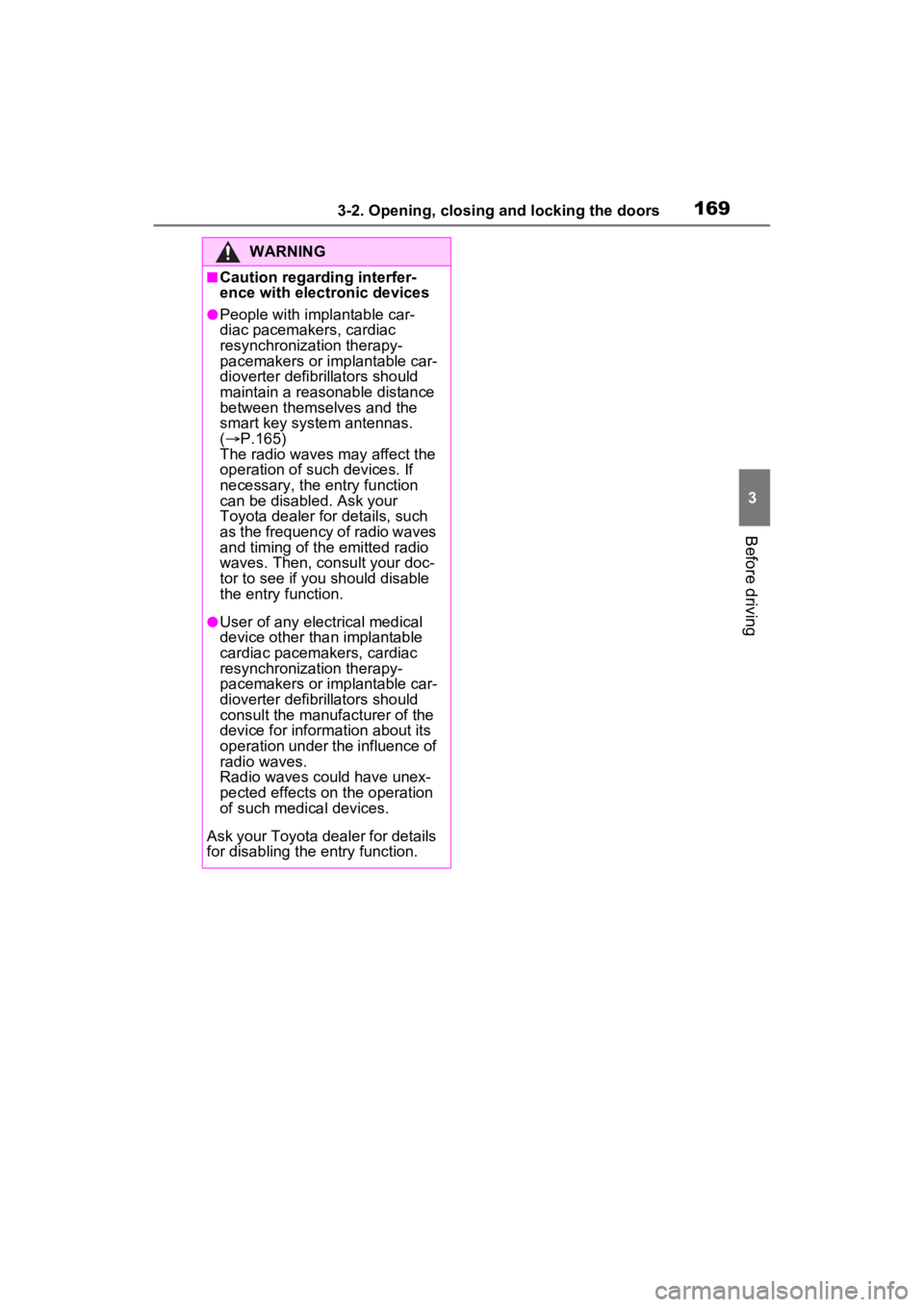
1693-2. Opening, closing and locking the doors
3
Before driving
WARNING
■Caution regarding interfer-
ence with electronic devices
●People with implantable car-
diac pacemakers, cardiac
resynchronization therapy-
pacemakers or implantable car-
dioverter defibrillators should
maintain a reasonable distance
between themselves and the
smart key system antennas.
( P.165)
The radio waves may affect the
operation of such devices. If
necessary, the entry function
can be disabled. Ask your
Toyota dealer for details, such
as the frequency of radio waves
and timing of the emitted radio
waves. Then, con sult your doc-
tor to see if you should disable
the entry function.
●User of any electrical medical
device other than implantable
cardiac pacemakers, cardiac
resynchronization therapy-
pacemakers or implantable car-
dioverter defibrillators should
consult the manufacturer of the
device for information about its
operation under the influence of
radio waves.
Radio waves could have unex-
pected effects on the operation
of such medical devices.
Ask your Toyota dealer for details
for disabling the entry function.
Page 172 of 600
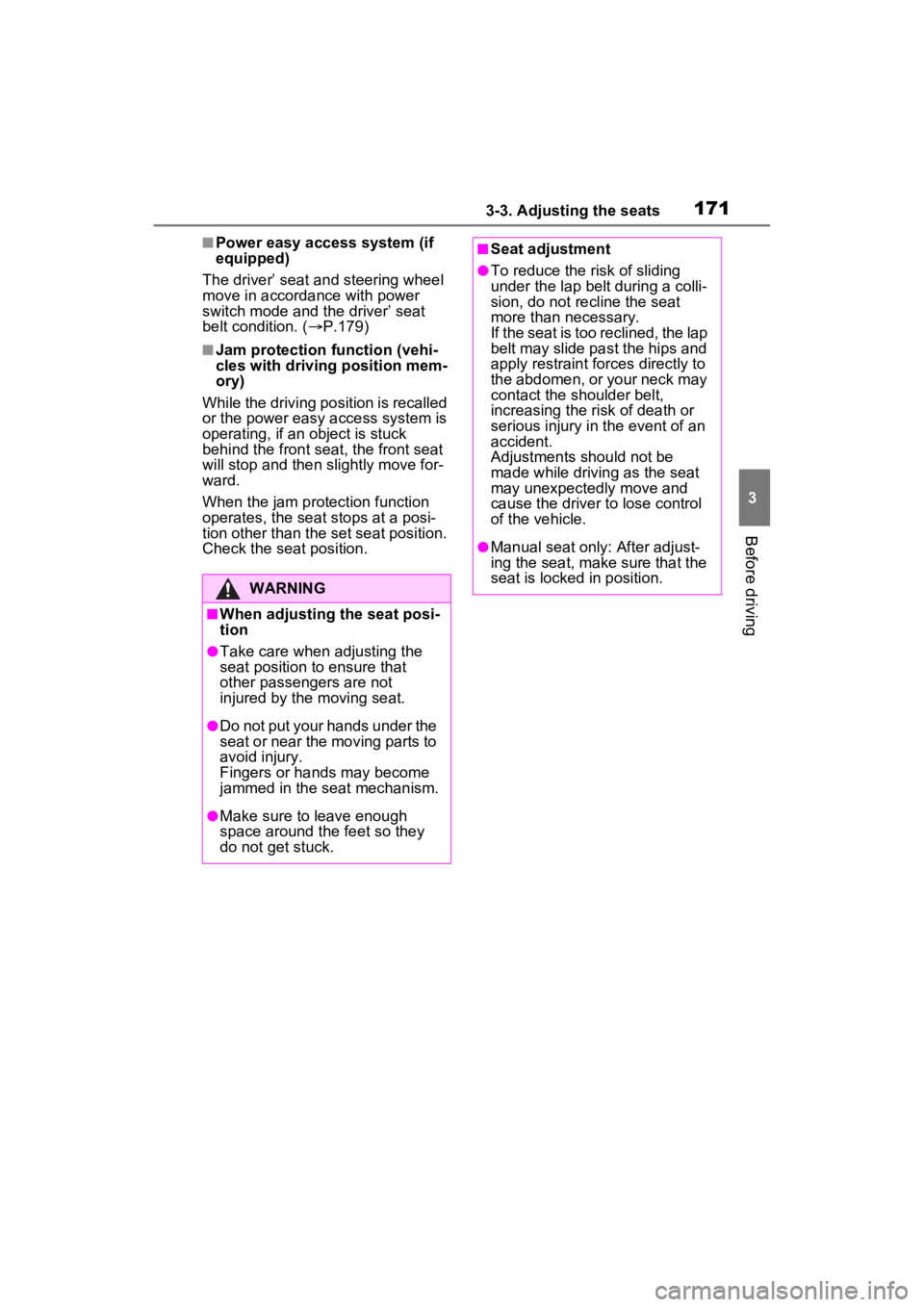
1713-3. Adjusting the seats
3
Before driving
■Power easy access system (if
equipped)
The driver’ seat and steering wheel
move in accordance with power
switch mode and the driver’ seat
belt condition. ( P.179)
■Jam protection function (vehi-
cles with driving position mem-
ory)
While the driving position is recalled
or the power easy access system is
operating, if an object is stuck
behind the front sea t, the front seat
will stop and then slightly move for-
ward.
When the jam protection function
operates, the seat stops at a posi-
tion other than the set seat position.
Check the seat position.
WARNING
■When adjusting the seat posi-
tion
●Take care when adjusting the
seat position to ensure that
other passengers are not
injured by the moving seat.
●Do not put your hands under the
seat or near the moving parts to
avoid injury.
Fingers or hands may become
jammed in the seat mechanism.
●Make sure to leave enough
space around the feet so they
do not get stuck.
■Seat adjustment
●To reduce the risk of sliding
under the lap bel t during a colli-
sion, do not recline the seat
more than necessary.
If the seat is too reclined, the lap
belt may slide past the hips and
apply restraint forces directly to
the abdomen, or your neck may
contact the shoulder belt,
increasing the risk of death or
serious injury in the event of an
accident.
Adjustments should not be
made while driving as the seat
may unexpectedly move and
cause the driver to lose control
of the vehicle.
●Manual seat only: After adjust-
ing the seat, make sure that the
seat is locked in position.
Page 174 of 600
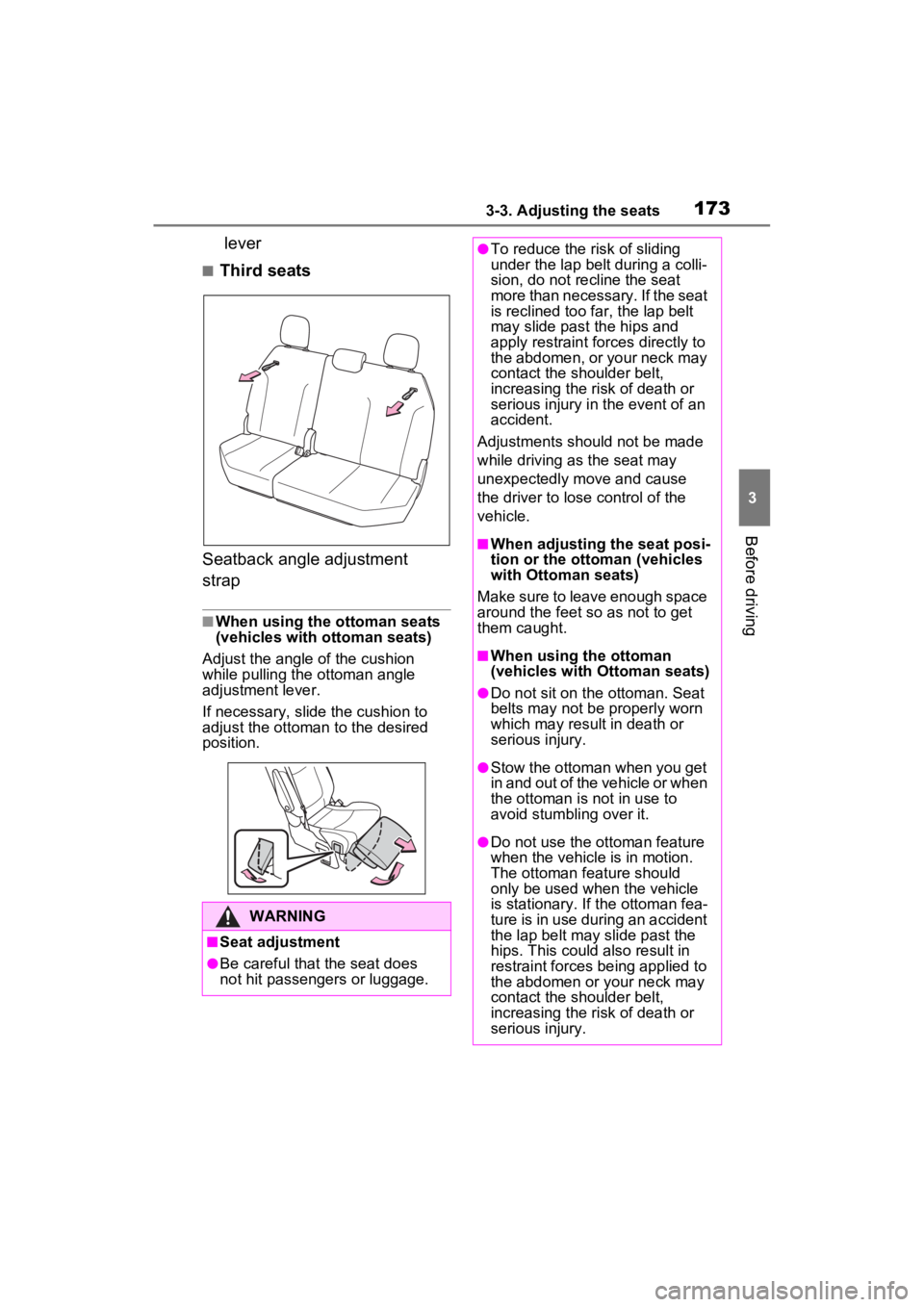
1733-3. Adjusting the seats
3
Before driving
lever
■Third seats
Seatback angle adjustment
strap
■When using the ottoman seats
(vehicles with o ttoman seats)
Adjust the angle of the cushion
while pulling the ottoman angle
adjustment lever.
If necessary, sli de the cushion to
adjust the ottoman to the desired
position.
WARNING
■Seat adjustment
●Be careful that the seat does
not hit passengers or luggage.
●To reduce the risk of sliding
under the lap bel t during a colli-
sion, do not recline the seat
more than necessary. If the seat
is reclined too far, the lap belt
may slide past the hips and
apply restraint forces directly to
the abdomen, or your neck may
contact the shoulder belt,
increasing the risk of death or
serious injury in the event of an
accident.
Adjustments should not be made
while driving as the seat may
unexpectedly move and cause
the driver to lose control of the
vehicle.
■When adjusting the seat posi-
tion or the ottoman (vehicles
with Ottoman seats)
Make sure to leave enough space
around the feet so as not to get
them caught.
■When using the ottoman
(vehicles with Ottoman seats)
●Do not sit on the ottoman. Seat
belts may not be properly worn
which may result in death or
serious injury.
●Stow the ottoman when you get
in and out of the vehicle or when
the ottoman is n ot in use to
avoid stumbling over it.
●Do not use the ottoman feature
when the vehicle is in motion.
The ottoman feature should
only be used when the vehicle
is stationary. If the ottoman fea-
ture is in use during an accident
the lap belt may slide past the
hips. This could also result in
restraint forces being applied to
the abdomen or your neck may
contact the shoulder belt,
increasing the risk of death or
serious injury.
Page 178 of 600
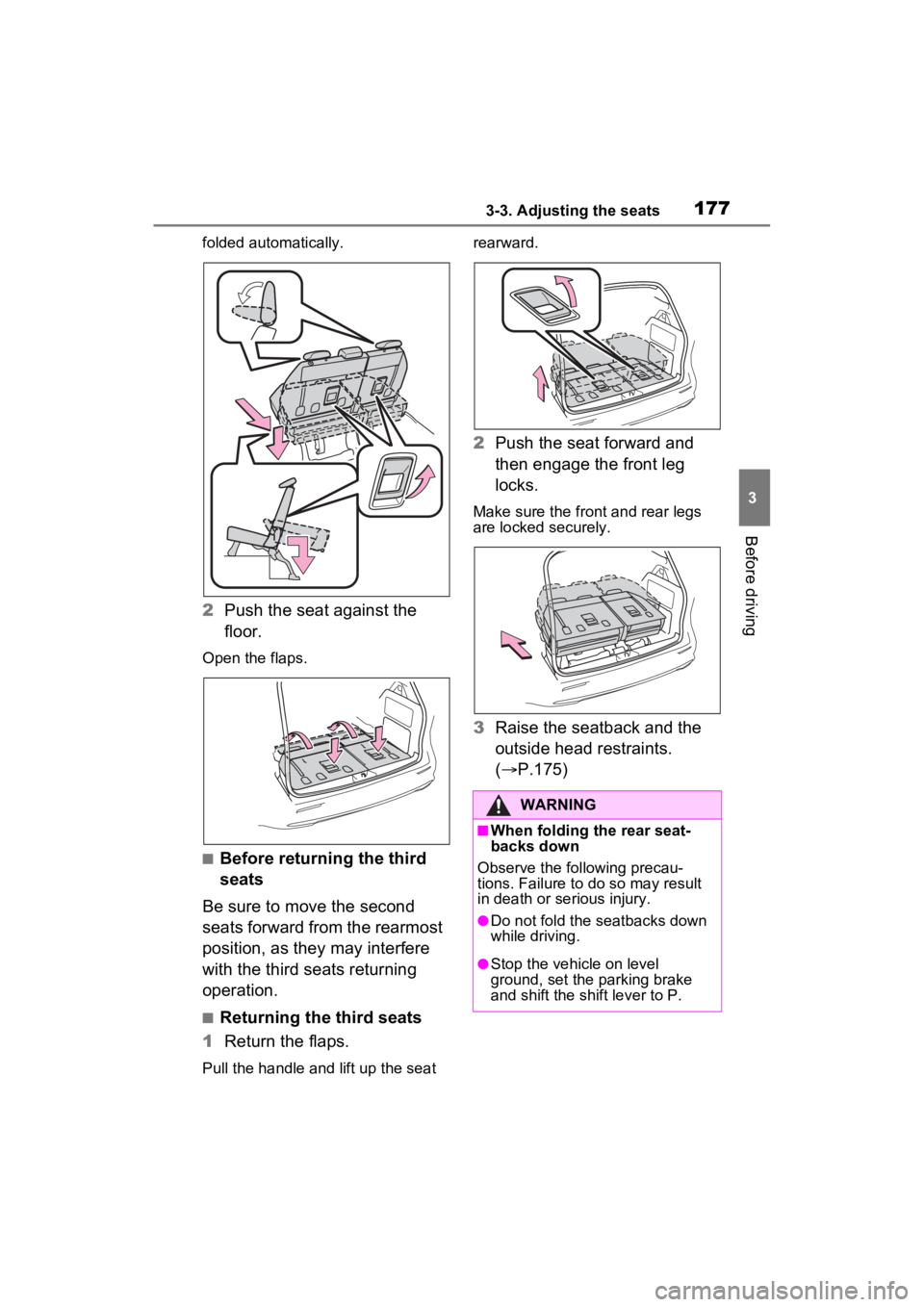
1773-3. Adjusting the seats
3
Before driving
folded automatically.
2Push the seat against the
floor.
Open the flaps.
■Before returning the third
seats
Be sure to move the second
seats forward from the rearmost
position, as they may interfere
with the third seats returning
operation.
■Returning the third seats
1 Return the flaps.
Pull the handle and lift up the seat rearward.
2
Push the seat forward and
then engage the front leg
locks.
Make sure the front and rear legs
are locked securely.
3Raise the seatback and the
outside head restraints.
( P.175)
WARNING
■When folding the rear seat-
backs down
Observe the following precau-
tions. Failure to do so may result
in death or serious injury.
●Do not fold the seatbacks down
while driving.
●Stop the vehicle on level
ground, set the parking brake
and shift the shift lever to P.
Page 179 of 600
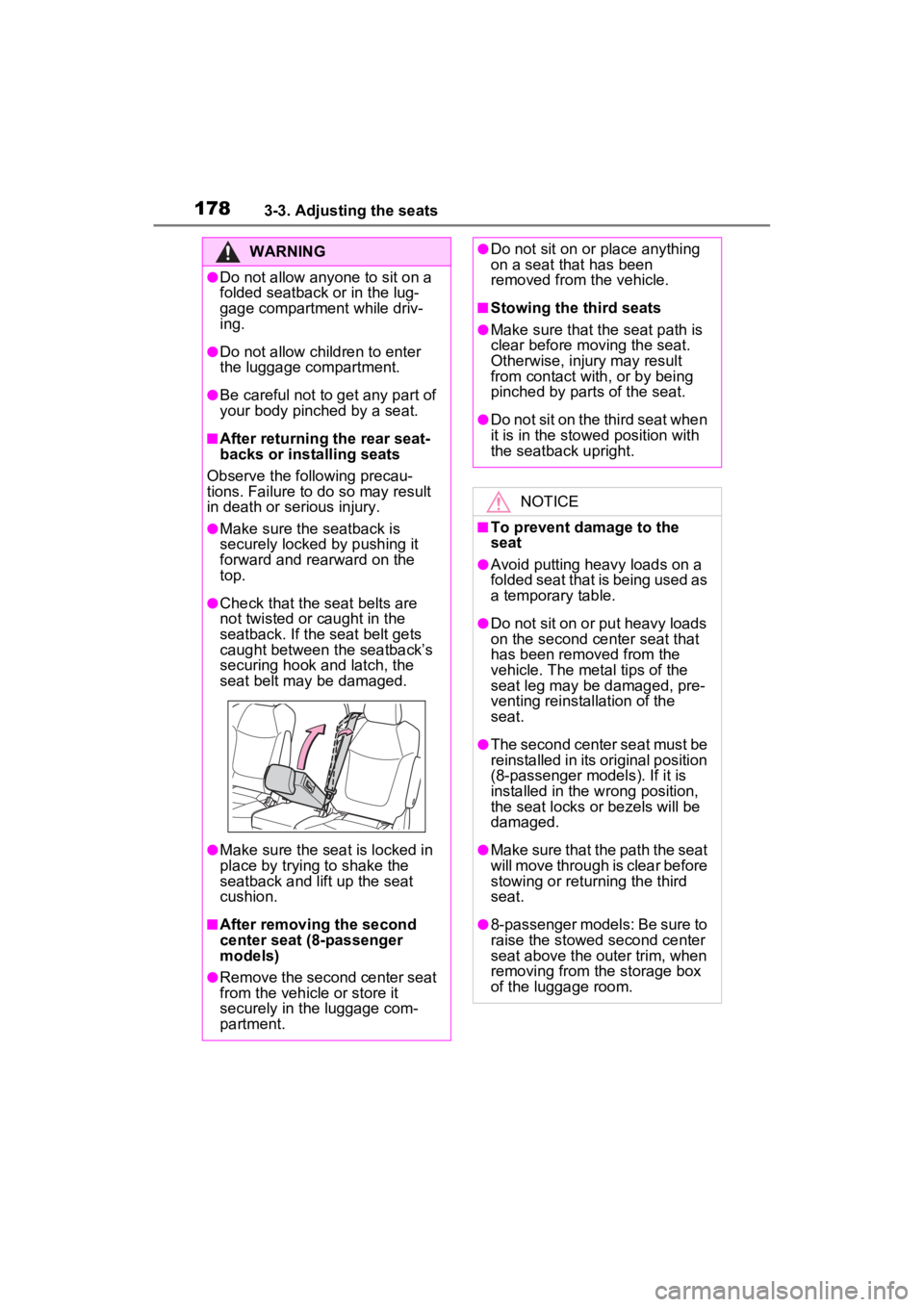
1783-3. Adjusting the seats
WARNING
●Do not allow anyone to sit on a
folded seatback or in the lug-
gage compartment while driv-
ing.
●Do not allow child ren to enter
the luggage compartment.
●Be careful not to get any part of
your body pinched by a seat.
■After returning the rear seat-
backs or installing seats
Observe the following precau-
tions. Failure to do so may result
in death or serious injury.
●Make sure the seatback is
securely locked by pushing it
forward and rearward on the
top.
●Check that the seat belts are
not twisted or caught in the
seatback. If the seat belt gets
caught between the seatback’s
securing hook and latch, the
seat belt may be damaged.
●Make sure the seat is locked in
place by trying to shake the
seatback and lift up the seat
cushion.
■After removi ng the second
center seat (8-passenger
models)
●Remove the second center seat
from the vehicle or store it
securely in the luggage com-
partment.
●Do not sit on or place anything
on a seat that has been
removed from the vehicle.
■Stowing the third seats
●Make sure that the seat path is
clear before moving the seat.
Otherwise, injury may result
from contact with, or by being
pinched by parts of the seat.
●Do not sit on the third seat when
it is in the stowed position with
the seatback upright.
NOTICE
■To prevent damage to the
seat
●Avoid putting heavy loads on a
folded seat that is being used as
a temporary table.
●Do not sit on or put heavy loads
on the second center seat that
has been removed from the
vehicle. The metal tips of the
seat leg may be damaged, pre-
venting reinstallation of the
seat.
●The second center seat must be
reinstalled in its original position
(8-passenger models). If it is
installed in the w rong position,
the seat locks or bezels will be
damaged.
●Make sure that the path the seat
will move through is clear before
stowing or returning the third
seat.
●8-passenger models: Be sure to
raise the stowed second center
seat above the outer trim, when
removing from the storage box
of the luggage room.
Page 182 of 600
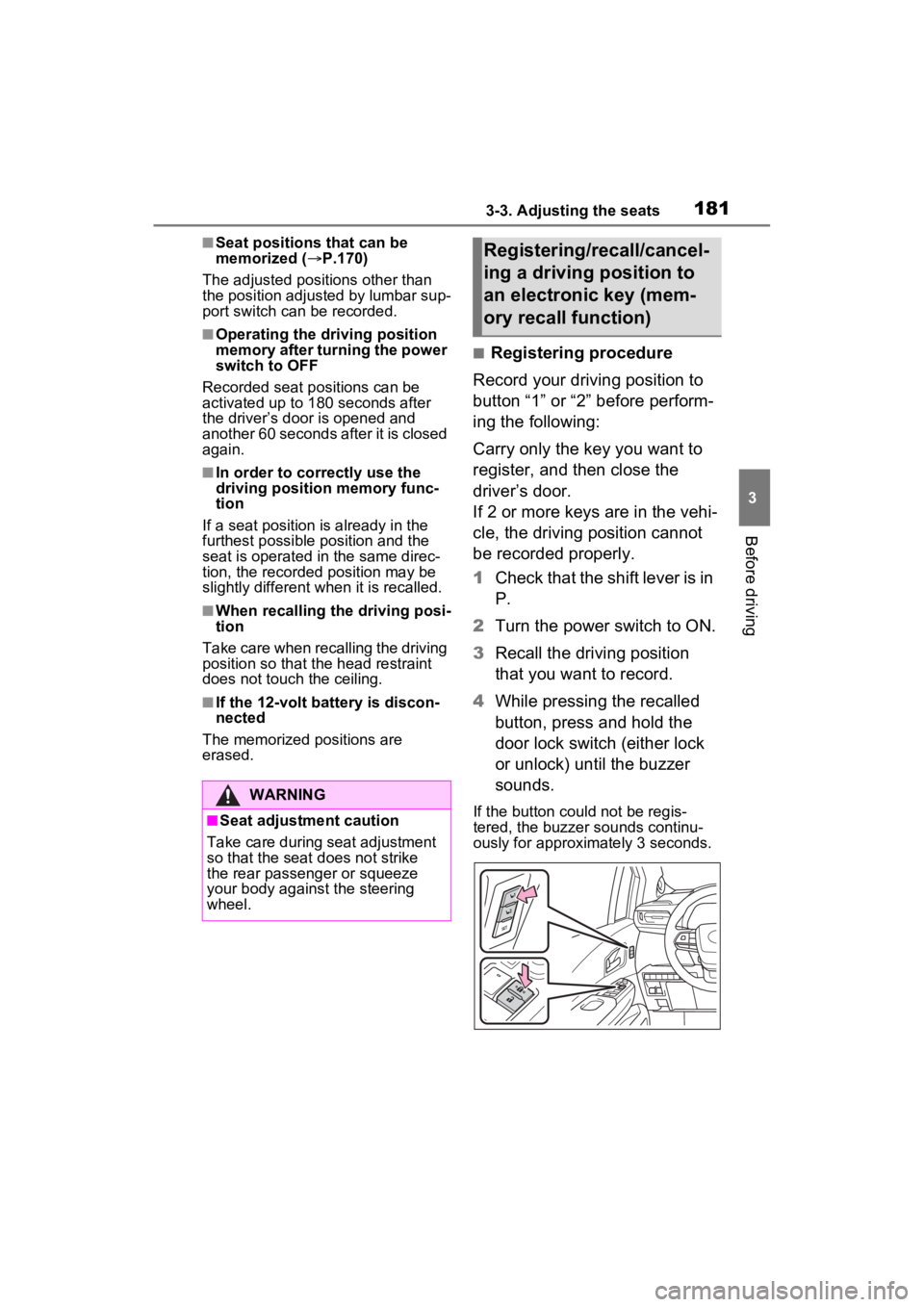
1813-3. Adjusting the seats
3
Before driving
■Seat positions that can be
memorized (P.170)
The adjusted positions other than
the position adjusted by lumbar sup-
port switch can be recorded.
■Operating the driving position
memory after turning the power
switch to OFF
Recorded seat positions can be
activated up to 1 80 seconds after
the driver’s door is opened and
another 60 seconds after it is closed
again.
■In order to correctly use the
driving position memory func-
tion
If a seat position is already in the
furthest possible position and the
seat is operated in the same direc-
tion, the recorded position may be
slightly different w hen it is recalled.
■When recalling the driving posi-
tion
Take care when recalling the driving
position so that the head restraint
does not touch the ceiling.
■If the 12-volt battery is discon-
nected
The memorized positions are
erased.
■Registering procedure
Record your driving position to
button “1” or “2” before perform-
ing the following:
Carry only the key you want to
register, and then close the
driver’s door.
If 2 or more keys are in the vehi-
cle, the driving position cannot
be recorded properly.
1 Check that the shift lever is in
P.
2 Turn the power switch to ON.
3 Recall the driving position
that you want to record.
4 While pressing the recalled
button, press and hold the
door lock switch (either lock
or unlock) until the buzzer
sounds.
If the button could not be regis-
tered, the buzzer sounds continu-
ously for approxim ately 3 seconds.
WARNING
■Seat adjustment caution
Take care during seat adjustment
so that the seat d oes not strike
the rear passenger or squeeze
your body again st the steering
wheel.
Registering/recall/cancel-
ing a driving position to
an electronic key (mem-
ory recall function)
Page 184 of 600
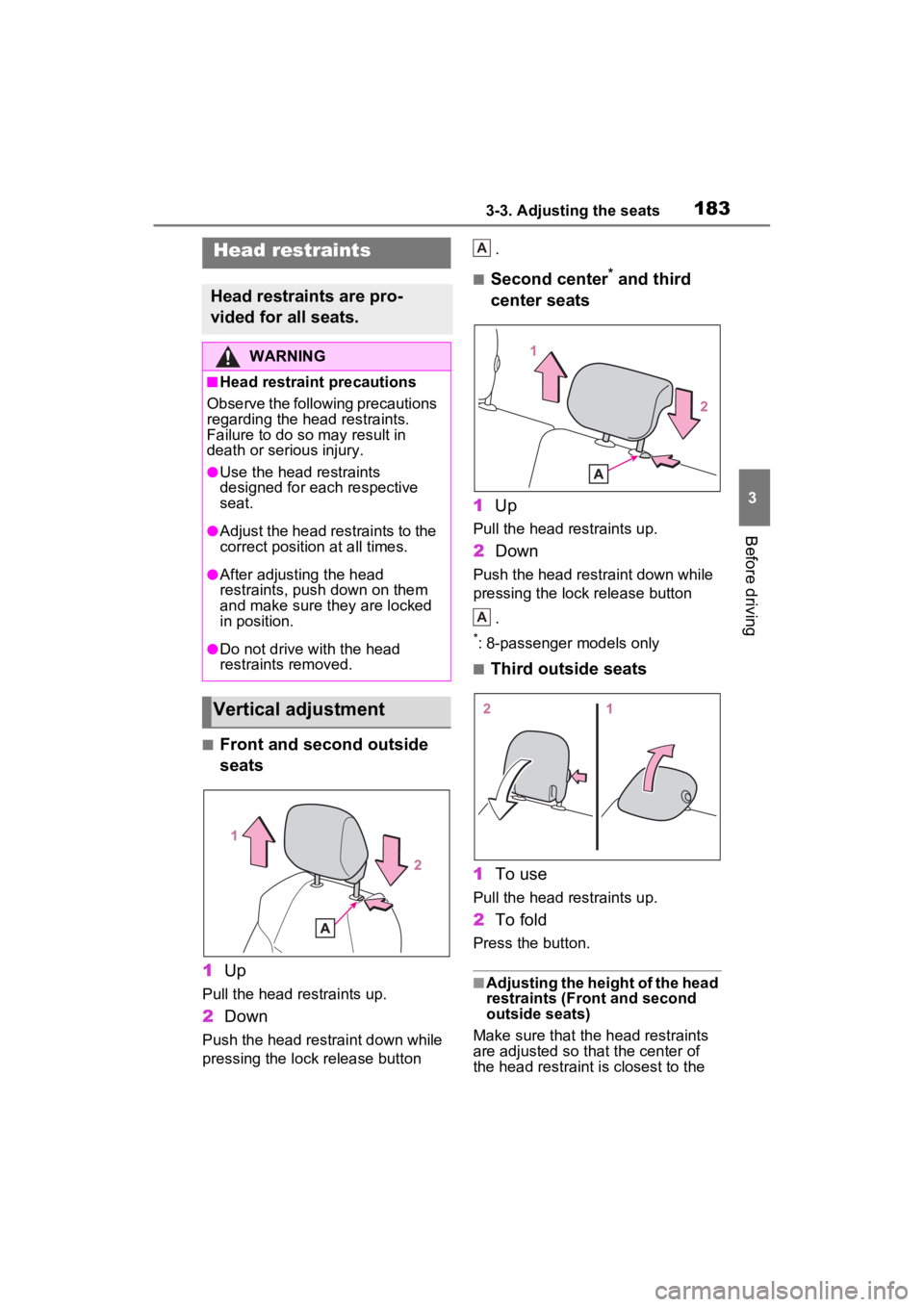
1833-3. Adjusting the seats
3
Before driving
■Front and second outside
seats
1 Up
Pull the head restraints up.
2Down
Push the head restraint down while
pressing the lock release button .
■Second center* and third
center seats
1 Up
Pull the head restraints up.
2Down
Push the head restraint down while
pressing the lock release button
.
*: 8-passenger models only
■Third outside seats
1 To use
Pull the head restraints up.
2To fold
Press the button.
■Adjusting the height of the head
restraints (Front and second
outside seats)
Make sure that the head restraints
are adjusted so that the center of
the head restraint i s closest to the
Head restraints
Head restraints are pro-
vided for all seats.
WARNING
■Head restraint precautions
Observe the following precautions
regarding the head restraints.
Failure to do so m ay result in
death or serious injury.
●Use the head restraints
designed for each respective
seat.
●Adjust the head restraints to the
correct position at all times.
●After adjusting the head
restraints, push down on them
and make sure they are locked
in position.
●Do not drive with the head
restraints removed.
Vertical adjustment
A
A
Page 188 of 600
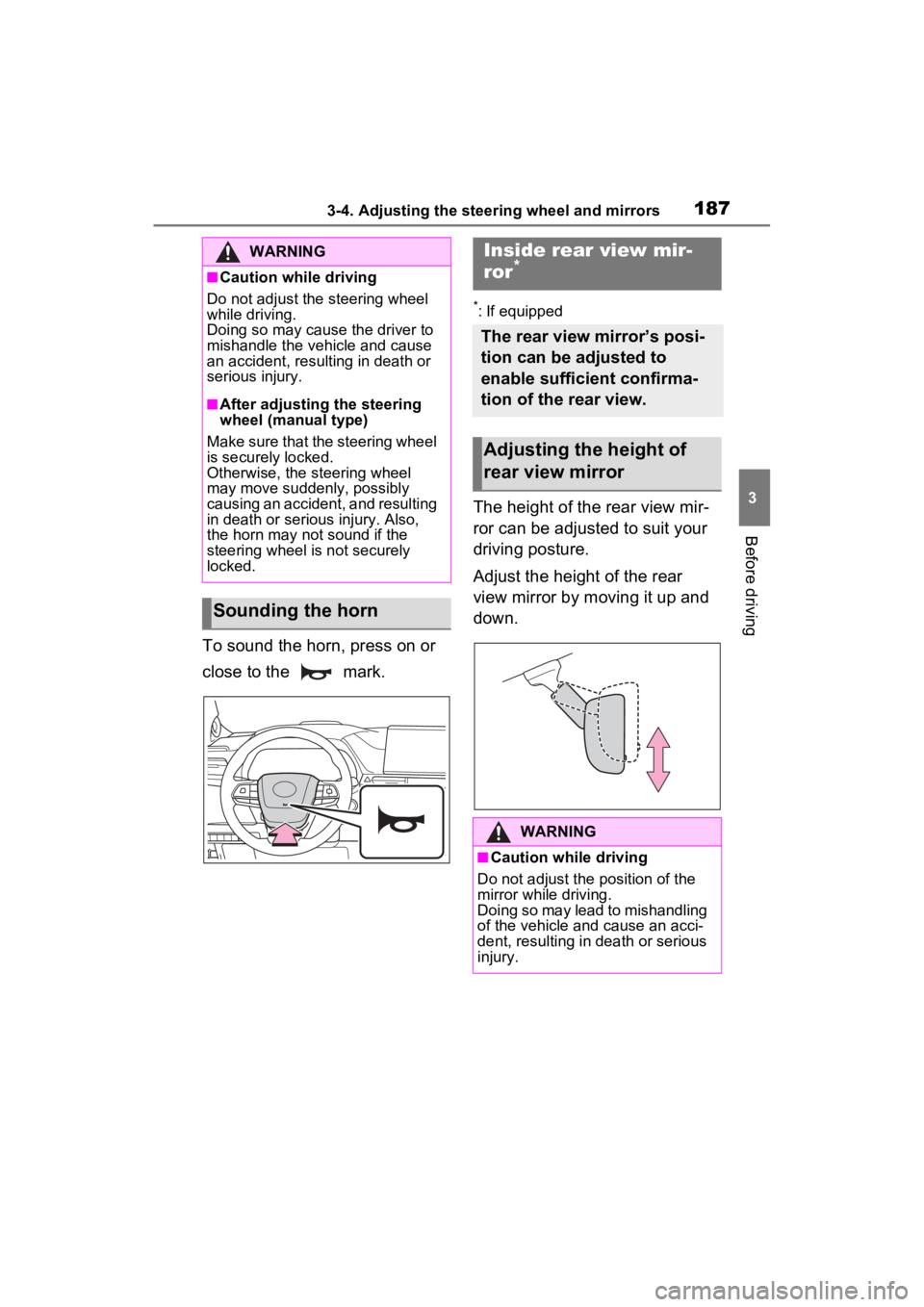
1873-4. Adjusting the steering wheel and mirrors
3
Before driving
To sound the horn, press on or
close to the mark.
*: If equipped
The height of the rear view mir-
ror can be adjusted to suit your
driving posture.
Adjust the height of the rear
view mirror by moving it up and
down.
WARNING
■Caution while driving
Do not adjust the steering wheel
while driving.
Doing so may cause the driver to
mishandle the vehicle and cause
an accident, resul ting in death or
serious injury.
■After adjusting the steering
wheel (manual type)
Make sure that the steering wheel
is securely locked.
Otherwise, the steering wheel
may move suddenly, possibly
causing an accident, and resulting
in death or serious injury. Also,
the horn may not sound if the
steering wheel is not securely
locked.
Sounding the horn
Inside rear view mir-
ror*
The rear view mirror’s posi-
tion can be adjusted to
enable sufficient confirma-
tion of the rear view.
Adjusting the height of
rear view mirror
WARNING
■Caution while driving
Do not adjust the position of the
mirror while driving.
Doing so may lead to mishandling
of the vehicle and cause an acci-
dent, resulting in death or serious
injury.